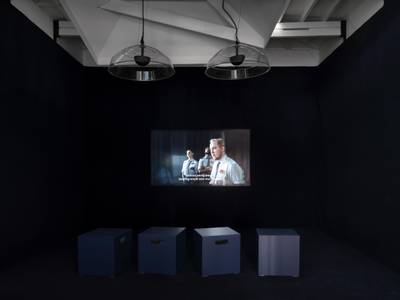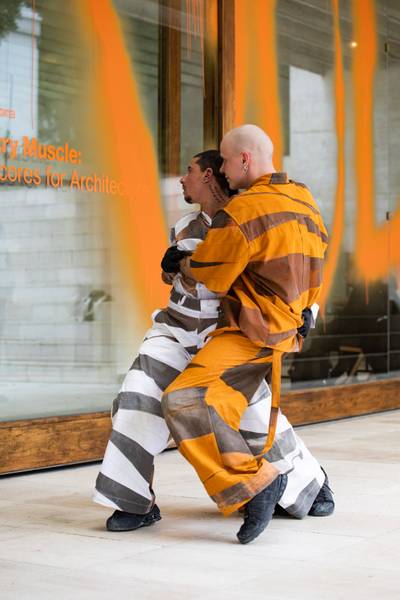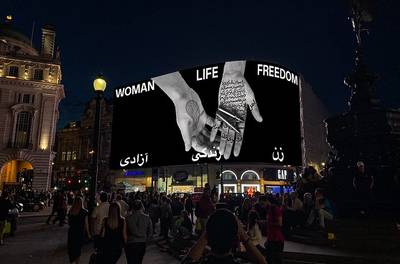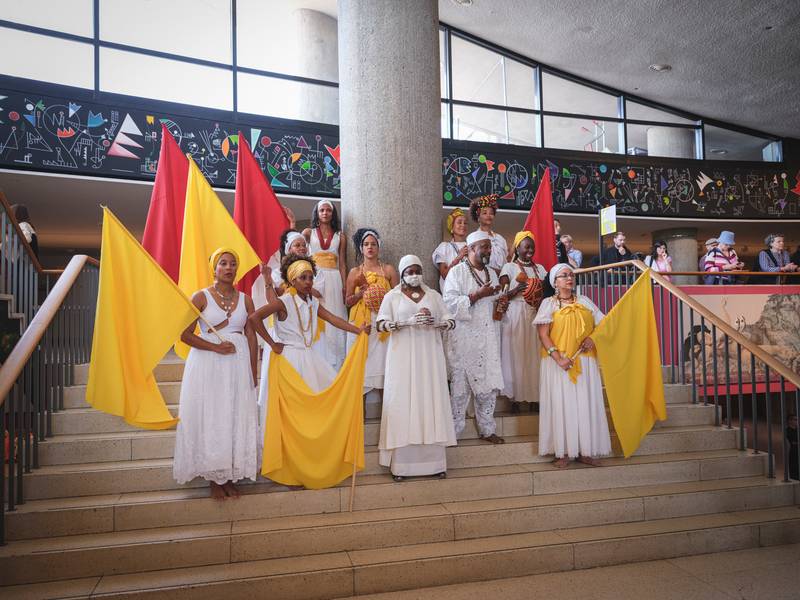

María Magdalena Campos-Pons, Baba Murah & Ensemble, Forum Brasil & Ilê Obá Sileké, Candomblé House in Berlin and Rasiel Almanza Cairo, When We Gather. Performance as part of Acts of Opening Again: A Choreography of Conviviality, Haus der Kulturen der Welt (HKW), Sylvia Wynter Foyer, 2.6.2023. Courtesy the artists. Photo: Marvin Systermans/HKW
Shaunak Mahbubani is a curator-writer based between Berlin and Mumbai. They primarily curate projects under the exhibition series Allies for the Uncertain Futures focused on exploring possibilities of co-visioning futures grounded in the pursuit of non-duality. The fourth iteration in this series, AUTOPOIESIS (2022—ongoing) has had manifestations across Mexico City, Guatemala City, New Delhi, and Berlin.
‘O Quilombismo: Of Resisting and Insisting. Of Flight as Fight. Of Other Democratic Egalitarian Political Philosophies’ | Group exhibition, research project, workshops, performances, publications | Haus der Kulturen der Welt (HKW), Berlin | June 2 – September 17, 2023
At Berlin’s House of World Cultures, the winds of change have been strong this year. Entering the driveway, we are greeted by Adama Delphine Fawundu’s flags, When the Spirits Dance, linking symbologies from West Africa with patterns akin to water bodies. Brightly coloured streamers bounding raumlaborberlin’s pavilion Shaped to the Measure of the People’s Songs (commissioned until 2027) continue the dance, leading up to Afro-Bahain artist Alberto Pitta’s large serigraph prints on the outer facade of the building, Ogum que são sete [Ogum who are seven] that calls on multiple forms of Ogum, a Yoruba deity of Candomblé known for his path-opening qualities.
Imbuing the surroundings of the building—colloquially called ‘the pregnant oyster’ by locals for its distinct curvilinear shape—with an energetic pluralism, these works break the stoic sanctity that the art institution had come to be known for in the past few years. Frequently referred to as HKW (for the initials of its German name Haus der Kulturen der Welt) or the ‘House’, the institution was set up in 1989 in a former congress building gifted to West Germany by the United States in 1957. Its imposing presence is compounded by its location, as it sits in Berlin’s political center, a stone’s throw away from the parliament and Brandenburg Gate.
Opposite the entrance doors where Pitta’s serigraphs hang, an extension of the main building is covered in stitched jute sacks, many marked with the phrase “Ghana Cocoa Board”–a signature burlap installation by Ghanaian artist Ibrahim Mahama, who repurposes jute sacks, often alongside historical textiles, to create large-scale tapestries that enclose entire buildings. Through this act, the facade of these colonial structures is replaced with a commentary on the extractive circulation of goods, resources, and culture from the African continent while her people face significant barriers to free movement. On one of my visits to the House, a friend from outside of biennale-hopping circles looked at the installation and earnestly asked, “Is the building under construction?” In a sense, he hit the nail on the head.
HKW is in an exciting phase of ‘reconstruction’ following the appointment of the new director, Prof. Dr. Bonaventure Soh Bejeng Ndikung, in June 2021. The news of the Cameroon-born curator’s engagement as the institute’s first nonwhite director sent a bolt of excitement through Berlin’s art scene, where large institutions are led by white, largely male directors, and where artists of color, often instrumentalized to garner a progressive title for the city, still face incidences of institutional racism. Ndikung is best known for setting up SAVVY Contemporary in 2009, starting as a small multicultural exhibition space in a storefront in Neukolln and expanding into one of the most important discursive sites in the city. Alongside, his experience as a professor for the MA programme Spatial Strategies at the Weißensee School of Art, Berlin, as well as Curator at Large of documenta 14 in Kassel and Athens (2017), guest curator at Dak’Art - Biennale de l’Art Africain Contemporain 2018 in Dakar, Senegal, amongst other large exhibition projects, has no doubt bolstered his cause as well.
At a conference in 2017 on the theme of ‘Sacred Objects and Human Remains in Berlin Museums,’ Ndikung critiqued the structure of the “global museum” and the format of regional shows that tick cartographic checkboxes while changing nothing from within. He said, “What we’re asking for is not to put on a one-off show but to make us part of it. […] we are in the personnel, we make the programme, and also the audience has to be reflective of the society.” Officially taking up his position on January 1, 2023, the new director has stuck to his word, amassing a stellar international team, including Marie Hélène Pereira, the director of RAW Academy Senegal (2019-22) and Cosmin Costinaș, curator and director of Para Site Hong Kong (2011-22) to helm Performance Practices and Exhibition Practices respectively, alongside curators, writers, activists, and artists.
The presence of these multiple perspectives is distinctly visible in its re-opening exhibition and rich programming, which welcomed publics from June 2, 2023. A packed schedule of discussions, screenings, concerts and DJ sets on all three opening days kept energies elevated into the wee hours. A rupture—germinative, generative—marking a new era of the House was palpable. Rarely, if ever, has Berlin witnessed so many people from the Global Majority at a contemporary art event. It was one for the history books, a precious sample of the Quilombuismo spirit that the re-opening exhibition expands upon.
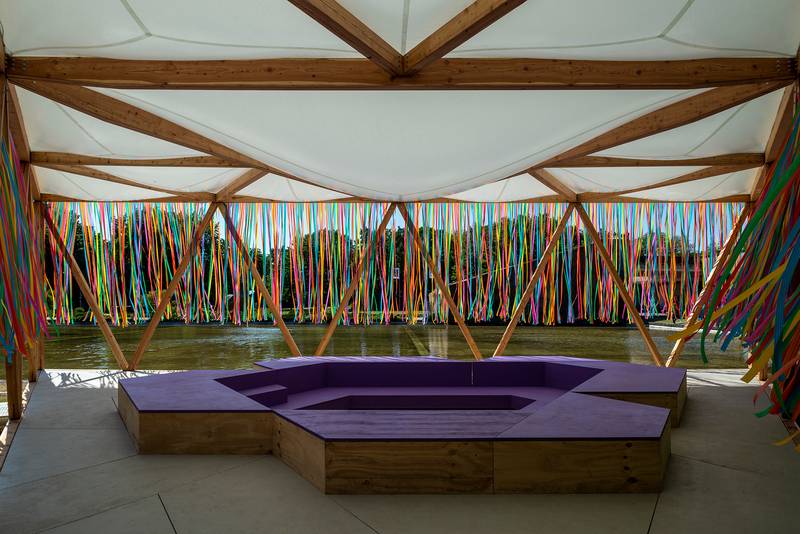

raumlaborberlin, pavilion part of Shaped to the Measure of the People’s Songs, Haus der Kulturen der Welt (HKW), 2023. Photo: Nin Solis/HKW
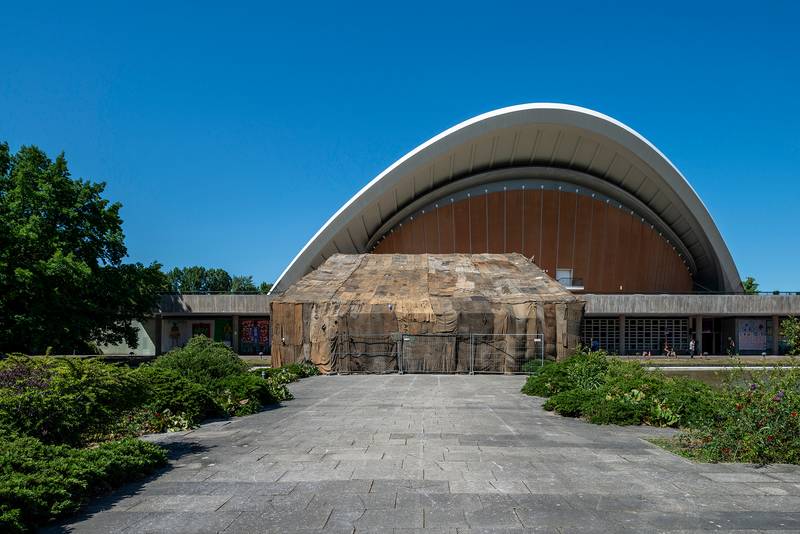

Ibrahim Mahama, IN THE GARDEN (2023), courtesy Apalazzo Gallery, White Cube Gallery and Red Clay Studio Tamale. Installation view of the exhibition O Quilombismo: Of Resisting and Insisting. Of Flight as Fight. Of Other Democratic Egalitarian Political Philosophies, Haus der Kulturen der Welt (HKW), 2023. Photo: Nin Solis/HKW
Quilombo: Of Fraternal and Free Reunion
Afro-Brazilian artist and theorist Abdias Nascimento, one of the backbones of the exhibition’s framework, delineates Quilombo as “fraternal and free reunion, or encounter; solidarity, living together, existential communication”,1 describing a movement for agency against colonial enslavement that originated in Brazil in the second half of the 17th Century. Nascimento expanded upon this historical legacy to develop a philosophy of quilombismo in the 1940s and onward. The exhibition features multiple paintings by him, proposing a form of language to portray the values of his philosophy, building upon Afro-Brazilian, West African, Egyptian and other contemporary resistance symbologies.
Drawing from the adinkra symbols and bodies of the Asante people of Ghana, the proposition of visual language is also central to the work of Owusu-Ankomah. His monochromatic paintings show a tight grid of this symbolic language, delicately refracted through the invisible shapes of life-size bodies, suggesting the importance of embodied production within knowledge systems. On the display wall in the centre of the Beatriz Nascimento Hall, we encounter a digital slideshow of paintings, drawings, and sculptures from the Museo de Arte Negra , founded in Rio (1950) by Theatro Experimental de Negro [Black Experimental Theater] and Abdias Nascimento. The written tour of the exhibition in the catalog describes this slideshow, which include the works of Sebastiao Januário, Jocelyn, Newton de Sá, Agenor Francisco dos Santos, José Hector da Silva, amongst many others, as a nucleus holding “affirmation and celebration of life, the possibility of existing in dignity”2.
A large number of the works on display are new commissions, a significant feat for an exhibition composed of artists from the Global Majority, signifying a push towards the circulation of resources from colonial coffers. While this process might be seen as one of its practical implementations, the exhibition at large does not address the economic aspect of Nascimento’s quilombismo philosophy. “As an economic system, Quilimbismo has meant the adaptation of African traditions of communitarianism and/or Ujamaa to the Brazilian environment. In such a system, relations of production differ basically from those that prevail in the capitalist economy, based on the exploitation and social degradation of work…”, Nascimento writes3. A proposal on how these traditions of communitarianism have been or might be applied to structures of contemporary art would have been highly valuable in the context of this show.
The display wall constructed in the shape of two asymmetrical curves in the center of the Beatriz Nascimento Hall is inspired by the linguistic symbology of the aforementioned works from the room. Breaking the strict right angles often encountered in museums, this shape, along with curved walls and platforms, imbues an organic atmosphere to the display of the exhibition. Inspired by the palette of Abdias Nascimento’s painting Oshunmaré Rising, bright orange, purple, blue, and green used on the walls and floors hold and nurture the diversely charged artworks.
The Beatriz Nascimento and Mrinalini Mukherjee Halls still enforce a certain distance between artwork and viewer, not offering spaces to sit or converge. The exhibition is dense and can be difficult for viewers to navigate, a fact that the exhibition text does not shy away from. There are no names or descriptions of the artworks within the physical space, and viewers are required to consistently orient themselves via the exhibition guidebook. Still, each viewing is highly rewarding and opens up a plethora of rich insights when one takes the time to make connections between the artworks included, or deep dives into the themes explored by the public programmes. For others, tours are organized almost every weekend throughout the duration of the show, unpacking aspects through interactions with different team members often in their native tongues. The frequency of these walkthroughs, the varied perspectives and multiple languages have been a strong factor in increasing accessibility to a complex presentation.
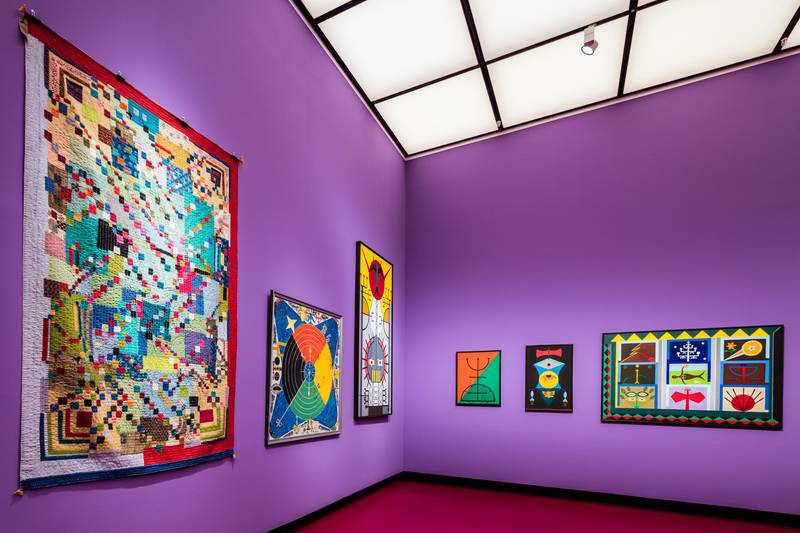

Hattarabi Maulasab Gunjavati, Untitled (2023); Everald Brown, Mystical Signs (1994), courtesy National Gallery of Jamaica; Abdias Nascimento, Ponto Riscado da Liberdade (Sacred Sign for Freedom, 1974), Quilombismo (Exu e Ogum, 1980), Afro Estandarte (African Standard, 1993), Teogonia Afro-Brasileira n. 2: Iansã, Obatalá, Oxum, Oxóssi, Yemanjá, Ogum, Ossaim, Xangô, Exu (Afro-Brazilian Theogony n. 2: Iansan, Obatala Oshun, Oshossi, Yemanja, Ogun, Osanyin, Shango, Eshu, 1972), courtesy Instituto de Pesquisas e Estudos Afro-Brasileiros IPEAFRO. Installation view of the exhibition O Quilombismo: Of Resisting and Insisting. Of Flight as Fight. Of Other Democratic Egalitarian Political Philosophies, Haus der Kulturen der Welt (HKW), 2023. Photo: Laura Fiorio/HKW
An Invocation to Other-Than-Human Forces
Starting from Adama Delphine Fawundu and Alberto Pitta’s flags and prints at the entrance and continuing into the exhibition rooms, an invocation to other-than-human forces to commune in the House is deeply felt. Ange Dakouo weaves a luminous constellation of talismans from his Donso community in the hanging tapestry, Imagine, holding protection and carrying knowledges of the connections between human and non-human beings. In close proximity, The Healing Stream by Jasmine Thomas-Girvan uses the cascading form of a paper scroll to foreground the importance of songs and stories in Black culture, specifically pointing to Rastafari culture. The delicate work has a rivulet of fluid lines in charcoal on dark grey paper, frequently perforated in the shapes of eyes, wings, and moving towards the crescendo to form a mystical landscape of raised cut-outs in the shapes of humans, flora, and fauna. Also playing with fluid forms, Li Jiun-Yang presents a technicolor dreamscape of imagined entities in the painting Fairy-Fairy-Fairy 35, asserting a traditional horizontally-structured Taiwanese identity distinct from Chinese Nationalism. An insistence to honor spiritual traditions and foreground practices that draw from faith is especially important here in Berlin, where an attitude of secularism is prevalent in the art world. This dismissal of religious perspectives has an effect of concealing the catholicism ingrained in the social fabric, and creating blindspots for recurrent prejudices such as islamophobia, anti-semitism, and Hindu casteism.
The Council of the Mother Spirits of the Animals, by Celia Vasquez Yui of the Shipibo People of Peru (with Diana Ruiz Vasquez), made using ancestral traditions of mixing broken ceramics with clay from the riverbanks from where they originated to create animal spirits represented as jaguars, armadillos, crocodiles etc.; and Truong Cong Tung’s Blind Map, where a colony of termites become collaborators in the work itself – both evoke the healing required for ecological justice. Spirit and animal beings converge in these works, often creating intricate patterns repeating and diverging with a harmonious balance that taps into the rhythms of the natural world. Tucked away in a room on the far side of the House, Hajra Waheed’s video, The Spiral, 2019, taps into the rhythms of the natural world proposing a spirituality that leans towards the personal and introspective. Soft phantom-esqe footage of forest foliage is backed by an ethereal voice-over creating a strong imprint — partly meditative and partly provocative. Waheed’s chronicle of the spiral suggested a fitting form for me to read this tenderly crafted exhibition, swirling together combinations of resistive acts, (un)rooted temporalities, and spirited flight, without a closed ending but rather creating a fertile stream in which we might enter to propose our own futurities.
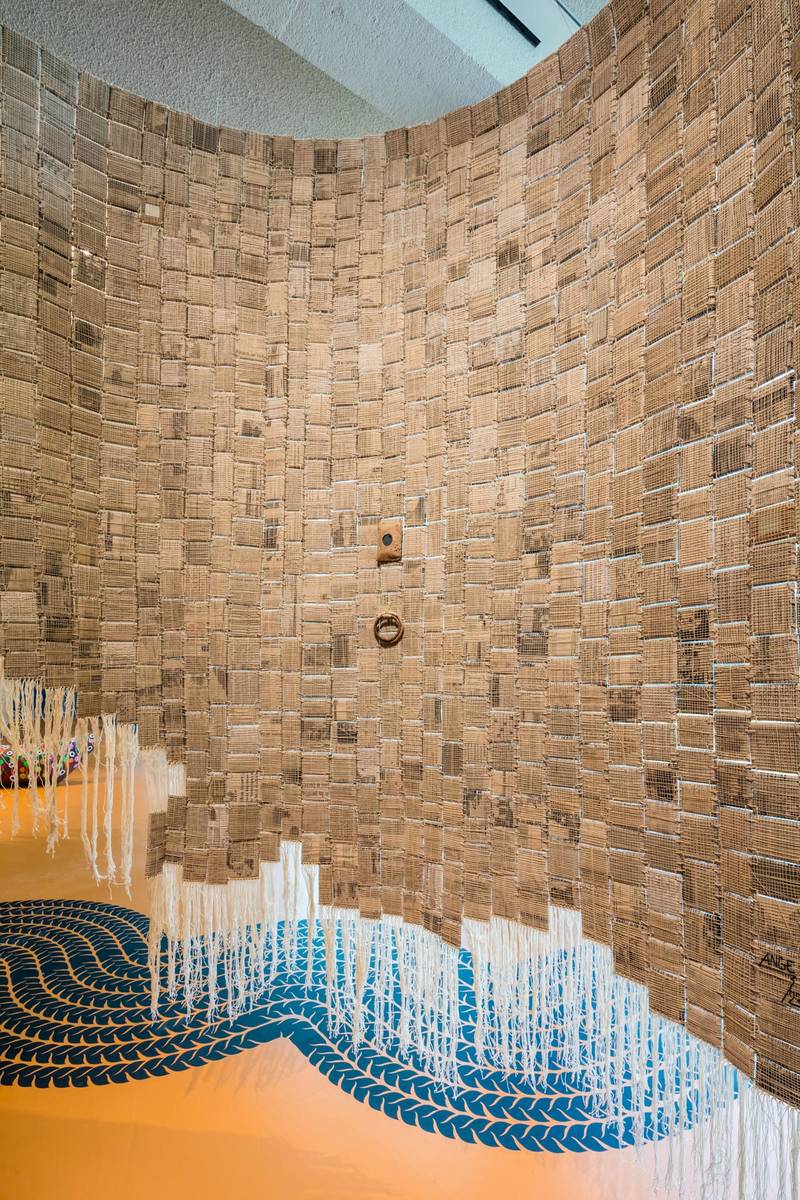

Ange Dakouo, Imagine (2023), courtesy the artist. Installation view of the exhibition O Quilombismo: Of Resisting and Insisting. Of Flight as Fight. Of Other Democratic Egalitarian Political Philosophies, Haus der Kulturen der Welt (HKW), 2023. Photo: Laura Fiorio/HKW
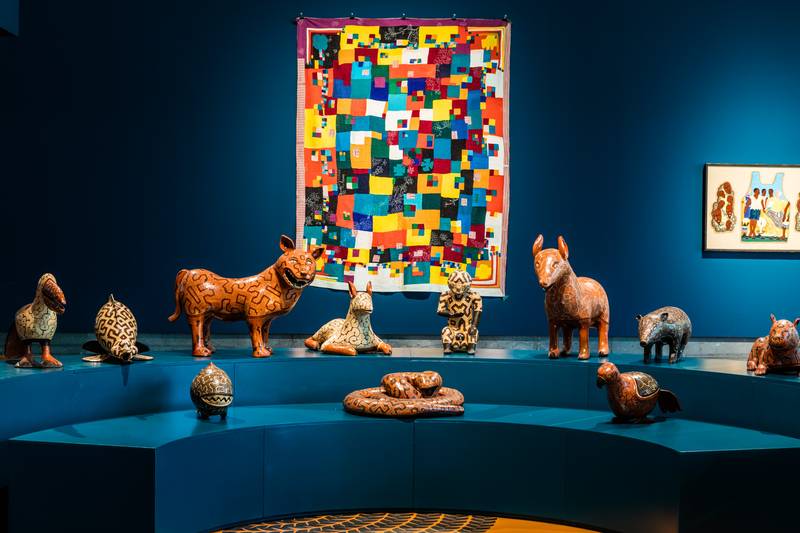

Celia Vasquez Yui with Diana Ruiz Vasquez, The Council of the Mother Spirits of the Animals (2020/23), courtesy the artists and Shipibo Conibo Center, NY; Bastin Santan Diggekar, Untitled (2023), courtesy the artist. Installation view of the exhibition O Quilombismo: Of Resisting and Insisting. Of Flight as Fight. Of Other Democratic Egalitarian Political Philosophies, Haus der Kulturen der Welt (HKW), 2023. Photo: Laura Fiorio/HKW
Centering Feminist Strategies
A crucial historical intersection between ecological sustenance and feminist resistance strategy is foregrounded in the works of Lizette Nin and Nontsikelelo Mutiti: Nin’s fabric painting, Trails, tells the story of seeds that were smuggled out from plantations in braided hair of escaping maroons to enable agriculture in their new settlements. A scenography of plants and crops growing out of intricate braided patterns suggests not only an inventive strategy but also highlights the role played by women in planting the ideas of these new lives. Mutiti’s large floor mural, Kubatana (togetherness / unity / connecting / touching / holding), also refers to the informative and emotive power of braiding techniques, celebrating the escape routes embedded in these patterns as a continued pathway for kinship amongst those of African descent, as well as here in the exhibition space.
The exhibition weaves together multiple instances of contemporary feminist collectivities. One amongst them, Hermosa Intervención, is a collective of Afro-Uraguayan women asserting the lives and histories of Afro-descendant women and queer folks in Abya Yala. In the documentary-style video, El Museo Afroviviente, 2023, they take us on their journey telling stories through performance, poetry, body paint, and installation across Uruguay. In the ‘Sylvia Wynter Foyer’, we get to asynchronously be a part of Barby Asante’s Declaration of Independence, 2017-ongoing, where the artist invites women of colour to co-create an affectual space of sharing and listening. The feminist philosophy of pluralism is seen in the practices and works of Bastin Santan Diggekar, Shakirambi Ganishab Tattongi, Bibijan Babushab Gunjavathi, Badimabi Gafarsab Ugrani, Hattarabi Maulasab Gunjavati, and Saidambi Imamasab Naik, from the Siddi community in Western India. Tracing their roots to the eastern part of the African continent, the community has settled over the western coast of the subcontinent over many centuries, adapting to forming their own multi-religious, multi-lingual identities, which are mirrored in the polychromatic patches that fill their quilts in dynamic harmony.
Keeping Energies High
The House has been hosting a frenzied schedule of talks, performances, concerts, and screenings, a weekend remembering the Haitian Revolution and a symposium interrogating the role of digitality and AI in oppressive structures. One of the highlights of the opening weekend was NOT waiting…, a performance by choreographers nora chipaumire and Germaine Acogny, accompanied and guided by a sonic ensemble played by five women from Toubab Dialaw, Senegal, recalling the chants that connect them to the water spirits who bring healing blessings to the community. Sonic Pluriverse Music Festival continued through the summer, activating the terrace and the restaurant to host concerts and DJ sets, with most of the invited musicians from African and South American lineages. Alongside, Bullerengue & Afro-Colombian Dance workshops were also held through the duration of the exhibition. These kinds of programming, both representative of varied heritages as well as creating spaces for embodied learning, attracted a broad range of audiences via the offer of options other than verbal discursive events.
Highly memorable amongst the programmes was the evening into the unfathomable pearl (tungo sa di-abot-diling perlas), in late June, “centring queer ancestry, its historical absence, and the possibilities it opens for connection with non-human entities, Indigenous knowledges, the fluid, sensual and fantastical dynamics of myths, and the telluric manifestations of the planet and the cosmos,”4 possibly the only that referenced the history of the specific location on which it took place, noting the founding of the Institut für Sexualwissenschaft in 1919 on the same grounds, later destroyed by National Socialists.
Led by the curator of performative practices Carlos Maria Romero AKA Atabey, the evening started by unpacking the practice of queer performance legend Joaquín La Habana. In an energetic, humorous conversation interspersed with archival footage and ending with a moving performance, La Habana took us through influences from his Afro-Cuban heritage, carnival and cabaret, family life as a queer elder, and his training as a Cuban Santería priest.
As we moved outside to the ‘Forough Farrokhzad Garden’, Joshua Serafin appeared on the roof of the House, momentarily embodying the oyster’s luminescent creation before running through the garden into a pool containing viscous black liquid. Serafin’s riveting performance VOID (also present in the exhibition as a video installation) confronts the paradoxical relation between invisibility and hyper-visibility for the trans* body, finding refuge in queer indigenous knowledge systems and kinship networks. The evening concluded with a screening of films from South-East Asia opening dialogue in relation to the transfemme figure of the so-called ladyboy—in South East Asia, co-conceptualised by Sarnt Utamachote, further explored through a conversation with Ragil Huda.
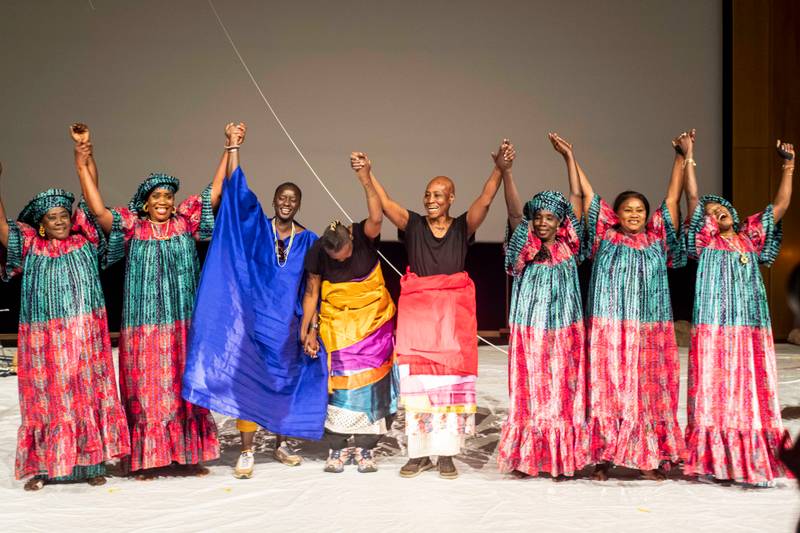

nora chipaumire and Germaine Acogny, NOT waiting… Performance as part of Acts of Opening Again: A Choreography of Conviviality, Haus der Kulturen der Welt (HKW), 2.6.2023. Courtesy the artists. Photo: Mathias Völzke/HKW
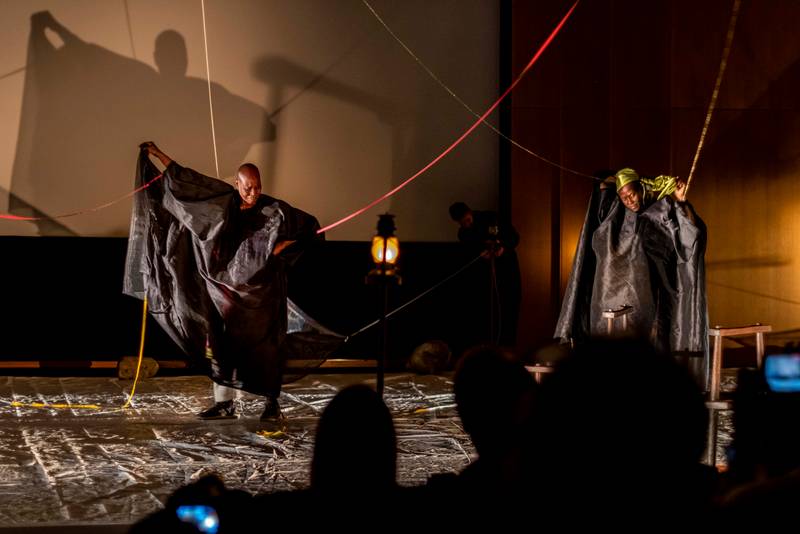

nora chipaumire and Germaine Acogny, NOT waiting… Performance as part of Acts of Opening Again: A Choreography of Conviviality, Haus der Kulturen der Welt (HKW), 2.6.2023. Courtesy the artists. Photo: Mathias Völzke/HKW
Invisibilized Lines
Symbolically reconstructing the neo-colonial architecture, the new team has taken the meaningful step of naming spaces inside and outside the building after historically important women artists and thinkers, including the ‘Sylvia Wynter Foyer’ after the Jamaican-born cultural theorist known for her reconfiguration of humanism through a displacement of the colonial ideal, ‘Mariam Makeba Auditorium’ for the South African singer-songwriter and civil rights activist, ‘Lili Elbe garden’ in memory of the Danish painter of trans experience, amongst the first to receive gender affirming surgery in Europe, and the ‘Semra Ertan Gardens’ honoring the Turkish writer who set herself ablaze in Hamburg protesting growing xenophobia in Germany where she migrated at age fifteen. According to a source from inside the institution, the new names are only in place for the duration of this director’s tenure, with no visibility on what would happen to them after. While some may decry these changes as purely symbolic, processes of writing alternate histories are composed of multiple decentralized gestures. The repetition of these names within the infrastructure - physical, administrative, printed, digital - of a German state cultural institution contributes to keeping the memory of their resistive acts alive.
Amongst these radical voices, a large hall named after the Indian sculptor Mrinalini Mukherjee seems out of place. While there is no doubt of the avant-garde nature of Mukherjee’s works, a closer look at her social position is warranted in this context. Mukherjee was born to a Brahmin father and a Sindhi mother5, both well-established artists in their own rights. She grew up around an “enviable milieu of cultural practitioners”6, showing her first solo exhibition at the age of 23. Simply locating Mukherjee as a brown South Asian woman artist does not recognise the inherent caste hierarchy embedded in the subcontinent and its diaspora. This gesture of renaming could instead have made visible ‘color lines within color lines’ to borrow from DuBois, and have memorialised radical feminists who do not have the cultural advantage of a big estate, such as pioneering indigenous Gond artist Durga Bai Vyam, Dalit-feminist writer-poet-publisher Rajni Tilak, or Gauri Lankesh, a journalist slain by Hindu-fundamentalist forces in 2017. Similarly disappointing is the inclusion of Anand Patwardhan’s take on the legacy of anti-caste poet Sambhaji Bhagat rather than a work by Bhagat himself or a filmmaker from the Dalit community. To bring these to light is not to mar the practices of Mukherjee or Patwardhan but rather to point towards the work that still needs to be done in Berlin and Europe at large towards understanding the nuances of caste hierarchies.
The Continuous Cultivation of Freedom
Simultaneously, as art workers put in the labor to expound the complexities of the Global Majority, the German state is clamping down on this discourse. Rules against non-violent protest gatherings and specific cultural symbols like the keffiyeh have created an autocratic environment in Berlin. Cultural spaces are being increasingly pressured to toe the line via claims of anti-semitic and anti-Israeli agendas. The smear campaign launched against the artists and curators of documenta fifteen in 2022 received widespread coverage, but the same tactics have also touched HKW before its change of leadership, Ndikung personally in late 2022, as well as other smaller institutions that have platformed Palestinian voices. Sources say that funding towards feminist and post-migrant projects is slowly drying up, a serious predicament for those who have thronged to Berlin for its open-mindedness. Within these circumstances, Ndikung’s maneuvering of state policy will provide a possible template for other art workers of color. As Ndikung notes in his catalog essay, “the real struggle begins through the maintenance of that [free] space”7, one sincerely hopes that HKW does not fall to a safe, centrist position, while acknowledging it is not their fight alone.
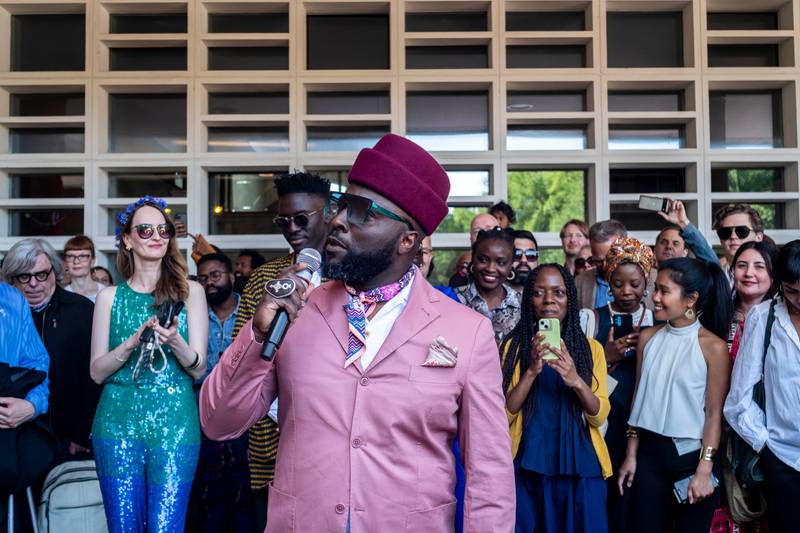

Welcome by Prof Dr Bonaventure Soh Bejeng Ndikung, Acts of Opening Again: A Choreography of Conviviality, Haus der Kulturen der Welt (HKW), 2.6.2023. Photo: Mathias Völzke/HKW


Welcome by Prof Dr Bonaventure Soh Bejeng Ndikung, Acts of Opening Again: A Choreography of Conviviality, Haus der Kulturen der Welt (HKW), 2.6.2023. Photo: Marvin Systermans/HKW
In the build up to the reopening, and reiterated at the launch, Ndikung has expressed his intention of creating a “House of many houses”. From what we have seen over the last few months, the process of reconstruction has tackled not only the facade, but has permeated many of the strata that make up a large institution to set up the foundation for such a plurality. These changes are visible across oft-foregrounded elements such as the new team, the artists included, methods of display, and the inclusive modes of programming, as well as in the small details such as the food on offer during events, the authors in the bookshop. The most heartening amongst these changes is the kinds of faces one sees in the audience. Rarely, if ever, has Berlin witnessed so many people from the Global Majority thronging, feeling welcome, and seeing themselves reflected in a contemporary art event.
Ndikung’s work at SAVVY Contemporary in creating a space that melded artistic pursuits with intellectual rigor, and his ability to “steer a house as a community focal point” was a significant factor in his selection for the leadership position at HKW.8 The specific criteria of gathering community, highlighted by secretary general of Germany’s culture ministry, Andreas Görgen, speaks to a shift occurring in the eyes of arts administrators, where visitor numbers are no longer the only priority. Rather, value has shifted to the ability of curators and organizers to create a space of sustained interactions, a task almost impossible without an embedded ethic of hospitality and care. In reflecting on the ways that this reconstruction has led to an atmosphere of spirited conviviality, I am reaffirmed in my belief that terms such as diversity and care cannot be keywords or metric goals, they must manifest as an equitable continual practice cultivated at every level of the institution; it is now time for others, stuck in their imperial ways, to follow suit.
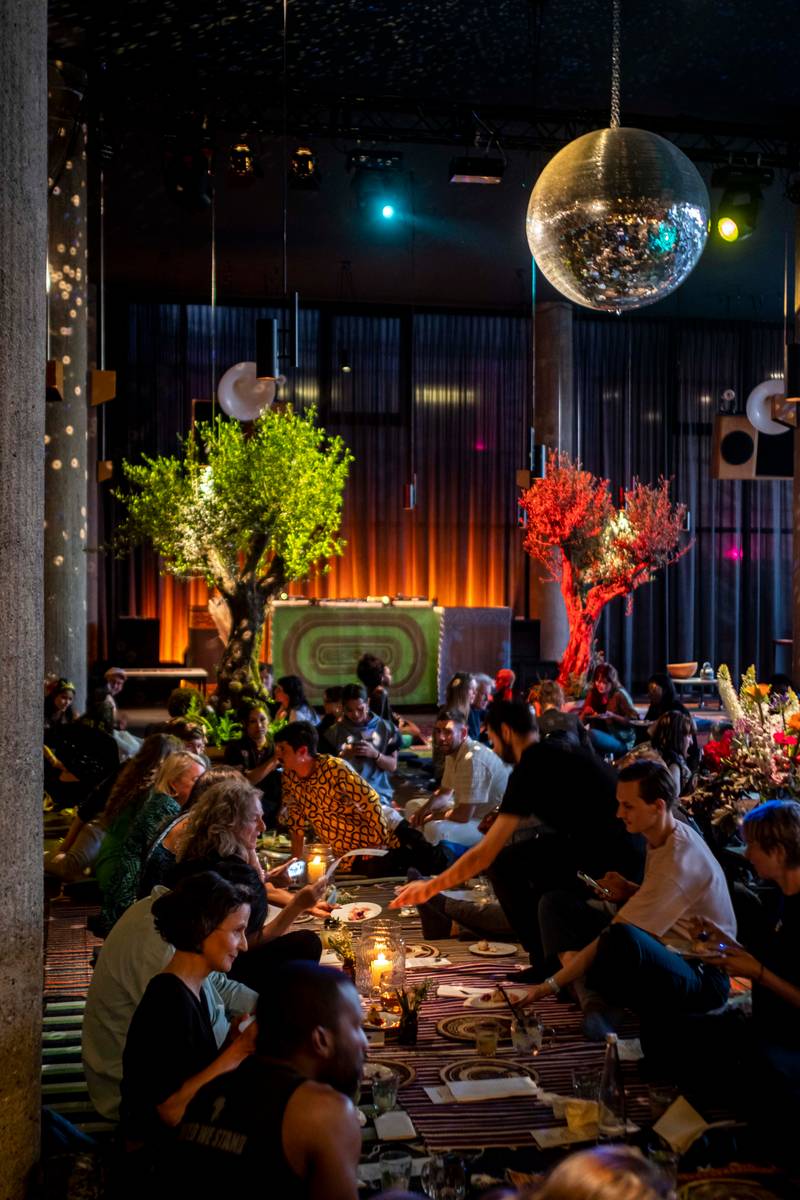

Dine on a Mat, Chef Fatmata Binta, Acts of Opening Again: A Choreography of Conviviality, Haus der Kulturen der Welt (HKW), 2.6.2023. Photo: Mathias Völzke/HKW
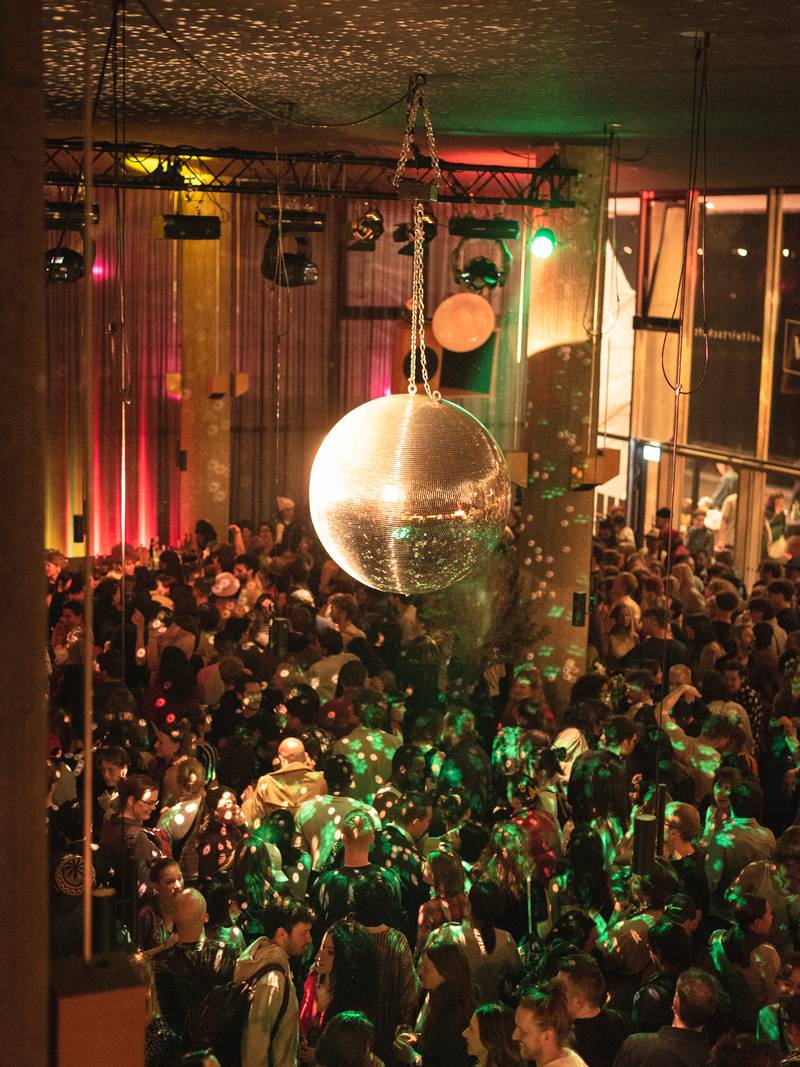

Sonic Pluriverse Festival, Congorama, Haus der Kulturen der Welt (HKW), 2.6.2023. Photo: Marvin Systermans/HKW
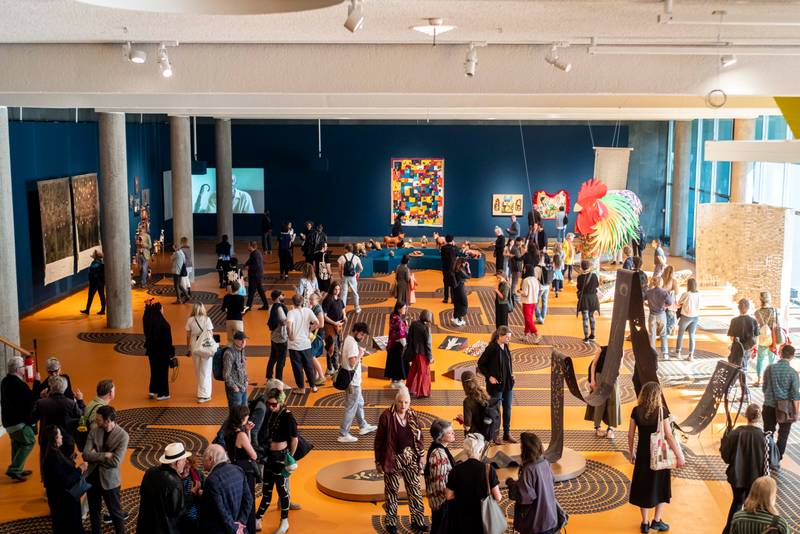

Acts of Opening Again: A Choreography of Conviviality, Haus der Kulturen der Welt (HKW), Mrinalili Mukherjee Hall, 2.6.2023. Photo: Mathias Völzke/HKW
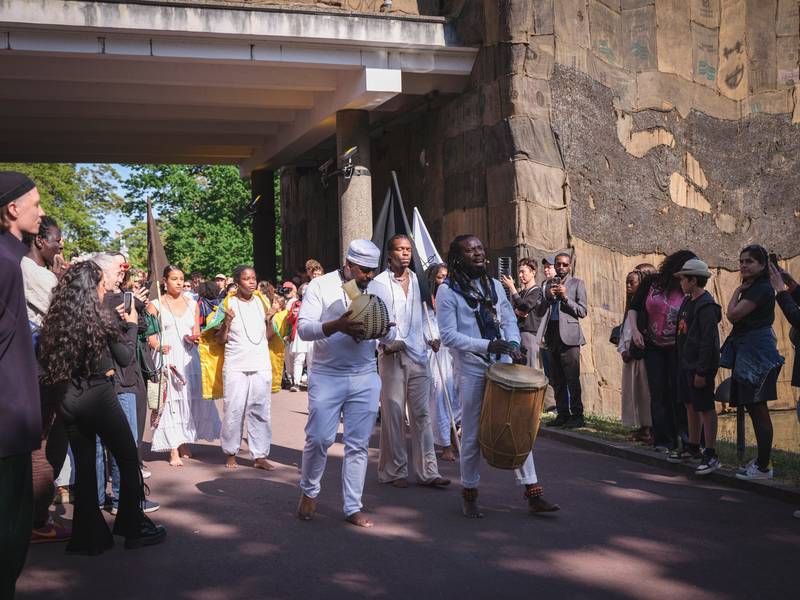

Houngan Jean-Daniel Lafontant with Claude Saturne, Invoking Papa Legba. Ceremonial opening in the course of Acts of Opening Again: A Choreography of Conviviality, Haus der Kulturen der Welt (HKW), 2.6.2023. Courtesy the artists. Photo: Marvin Systermans/HKW
